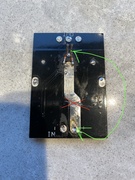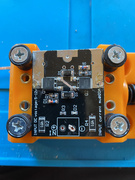Abysmal Vapor
Supersniffer 2000 - robot fart detection device
That looks intriguing. Where did you get it from "?And......this......

That looks intriguing. Where did you get it from "?And......this......


Reddit r/Dynavap think an 510 ih...That looks intriguing. Where did you get it from "?
Unfortunately dont have a current meter but I'll pick one up tomorrow, I'll just keep licking it to see where the current goes. Yes, the 12V+ goes to the chokeIs the positive 12V making it into the choke at the center tap? LEDs are over rated. Use a current meter to know what the module is doing.
So i can read Ampere and then adjust, volt, coil length ? How i can tune it, i would like a slow heat....about 20 second from coldThe very best way to know what your IH is doing is to read the current it is drawing with a meter. You want to draw 60-70 watts for a nice calm bake. At 80 watts, you start to loose vape to condensing on the walls of your device. All caps act differently in the IH.
 )is the depth of penetration.
)is the depth of penetration. .
. .
.The easiest way to tune an IH is to change the input voltage. Some kind of DC-DC converter or a variable voltage power supply. It will still vary depending on the cap, but voltage control does give you dynamic tuning.So i can read Ampere and then adjust, volt, coil length ? How i can tune it, i would like a slow heat....about 20 second from cold
Thanks, i have a standard zvs with only the capacitor off and stock coil.Coils are a wonderful adventure in themselves. The larger the ID, the less sensitive the ingress depth is. Also a handy way to dole out more wire.
Yes, as voltage decreases, current decreases. If you are after 50 watts, which is a calm oven similar to the Wand, 5 amps at 10 volts is perfect. If it draws 4.1 amps at 12 volts, who's the wiser? The variance in these calculations may be a single turn of the coil. If you have a stock coil on hand, I recommend using it as a baseline. You might find yourself liking it a lot.
 . I bridged the cut from the "loop" high current input wire to the original positive input. Do the bridge need to be as close to the cut as possible, as you have done in the "cap as switch" version imaged above?
. I bridged the cut from the "loop" high current input wire to the original positive input. Do the bridge need to be as close to the cut as possible, as you have done in the "cap as switch" version imaged above? 

Understand, i have to find a converter capable in Ampere like 12v 10A ? My caps are less than 5A only the 19M go up a little more at 12v. I plan to use for myself or friends with previousaamperage check.It shorted the second I turned it on, same thing with all the boards from the last batch. Checked the values and looked for shorts with a meter on all circuits before turning on the power. Couldn’t find any errors and the wiring is correct. I’m using a 3S pack with a 40A bms board and new VTC6 batteries. I have a 10A fuse to install when things are working as expected again.
Will try to salvage some fets from around and install in a used zvs that worked before. I’ve only had luck with half pint on the zvs with perforated boards and a thinner trace.
GI: you can use a buck converter on a 3S pack and regulate voltage, but it needs to be able to handle high current. The standard LM2596 won’t hold up. And yes you can add leds to the fire switch, not too many as it’s only about 400mah iirc.
